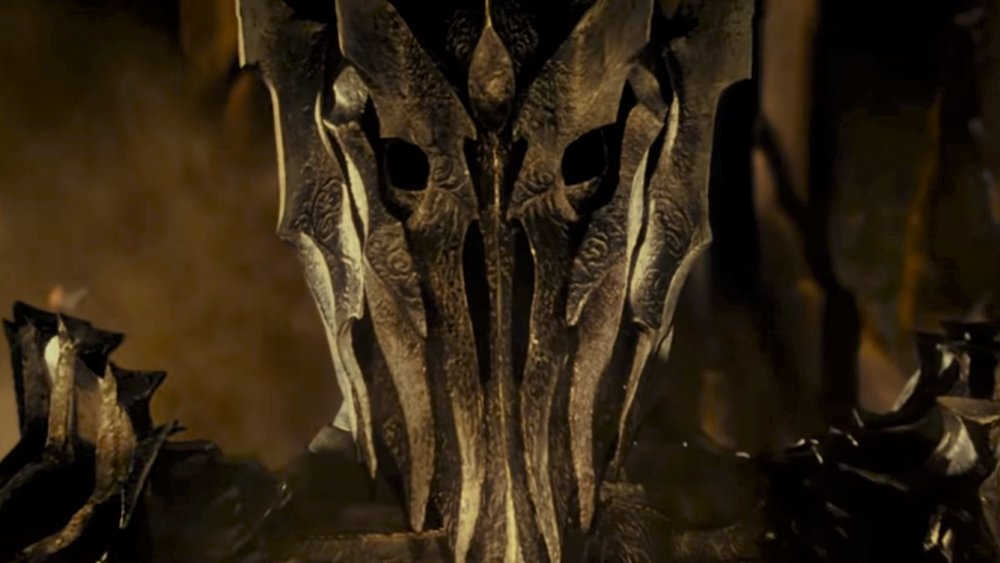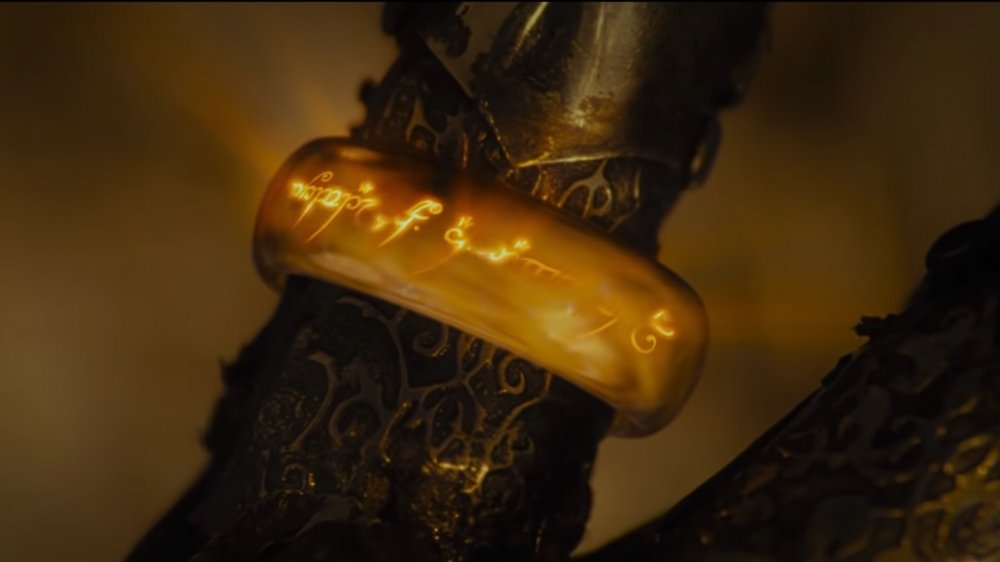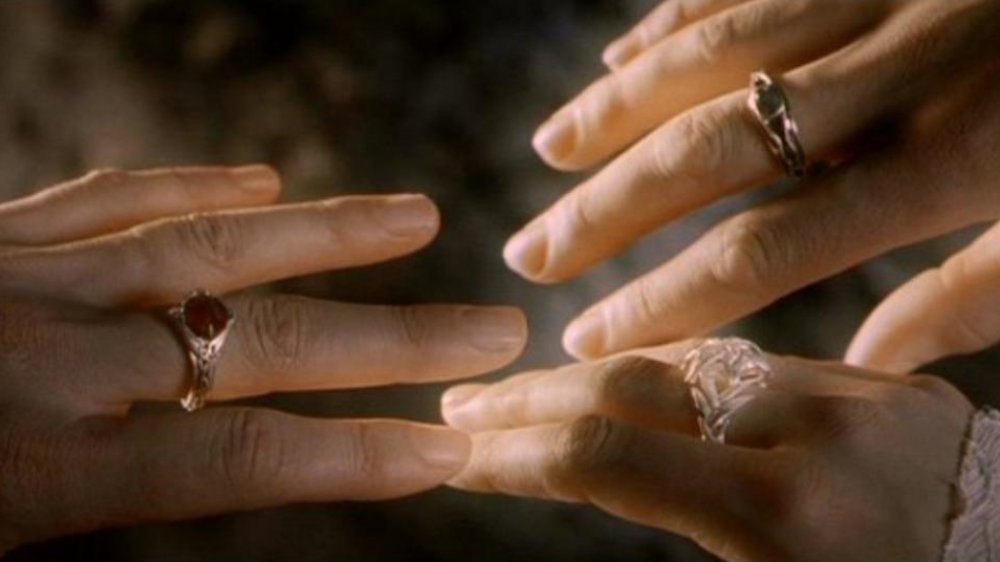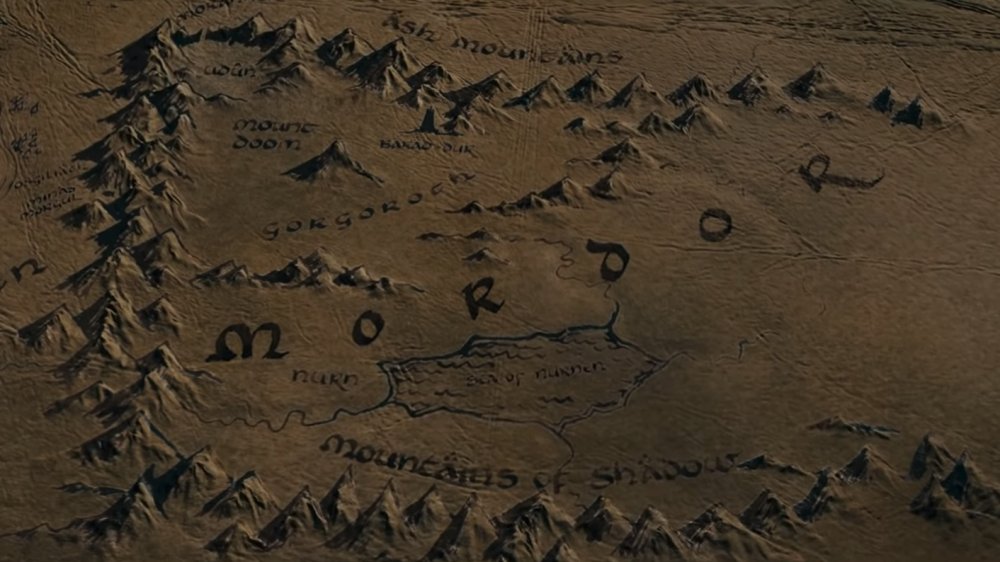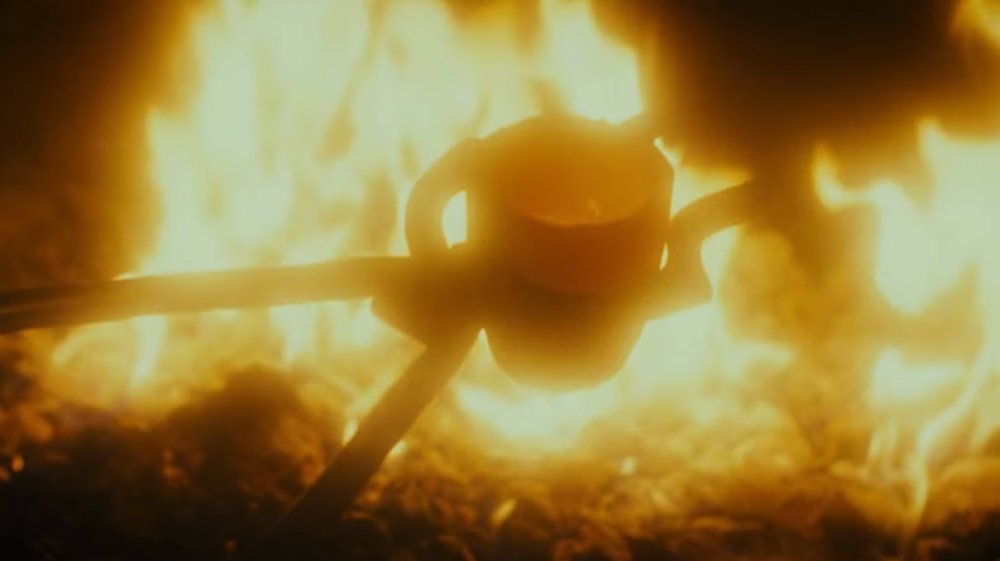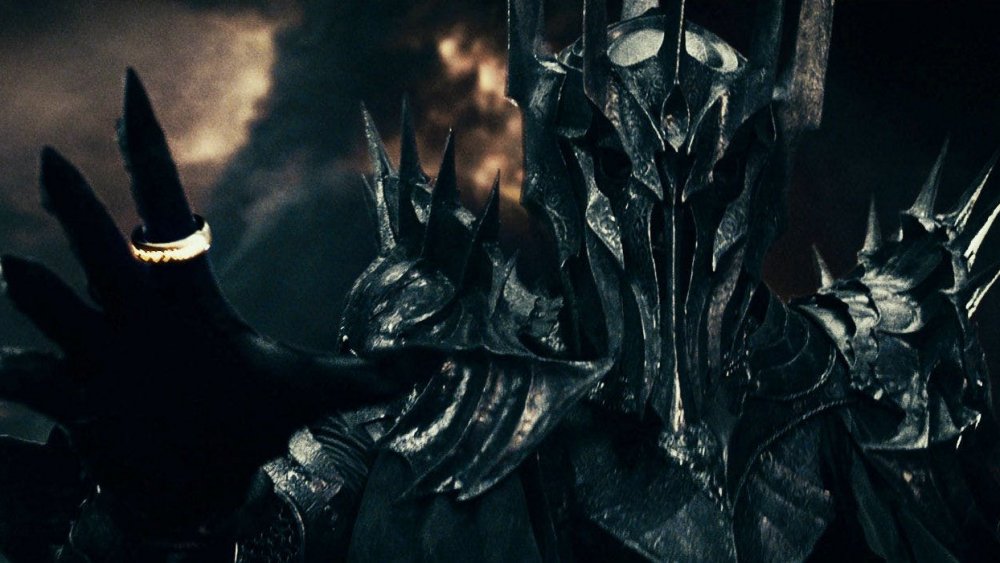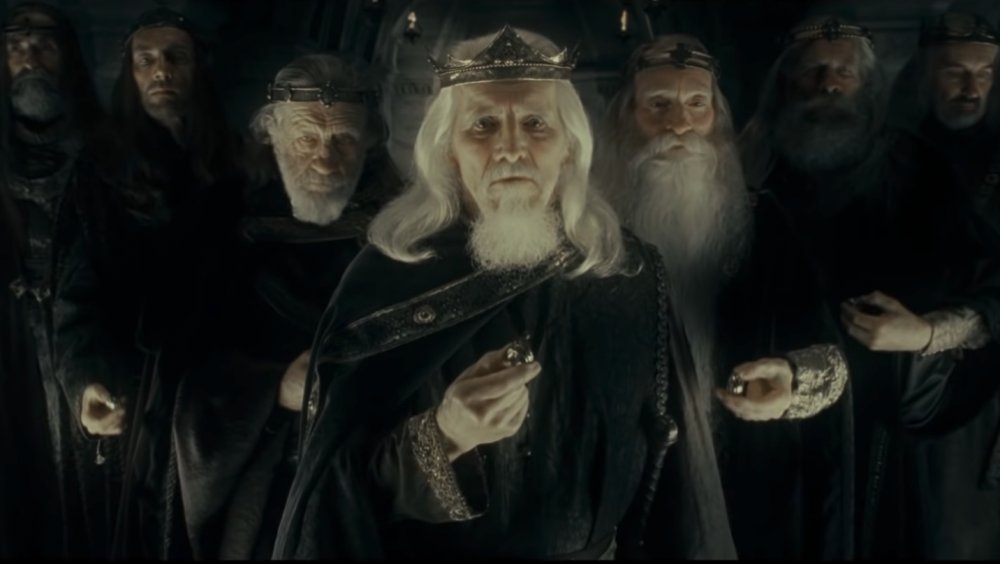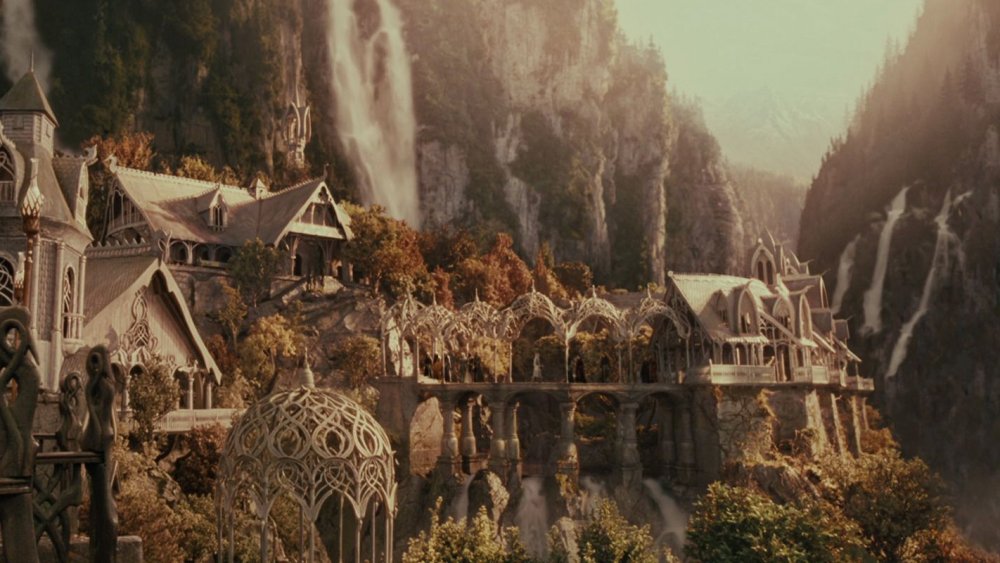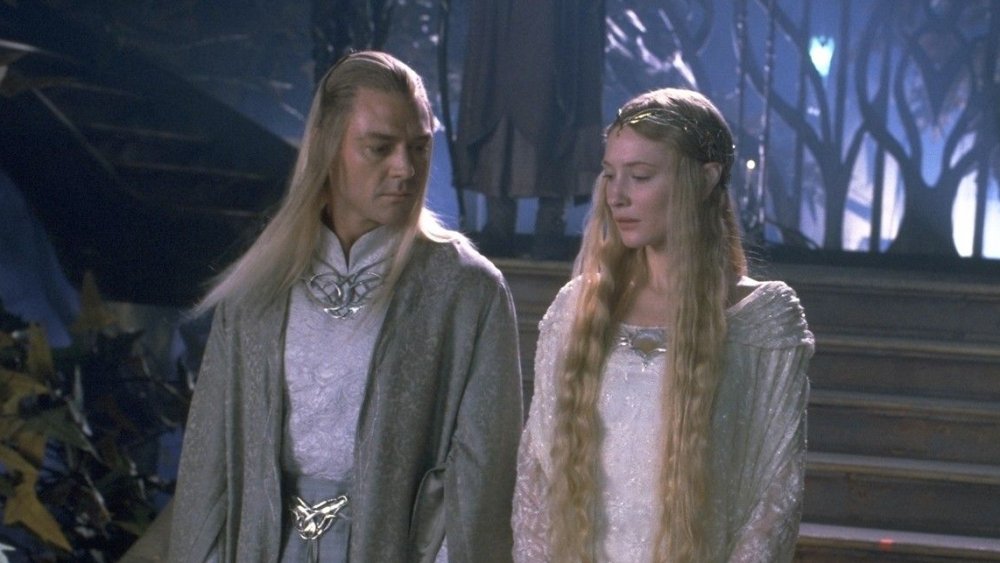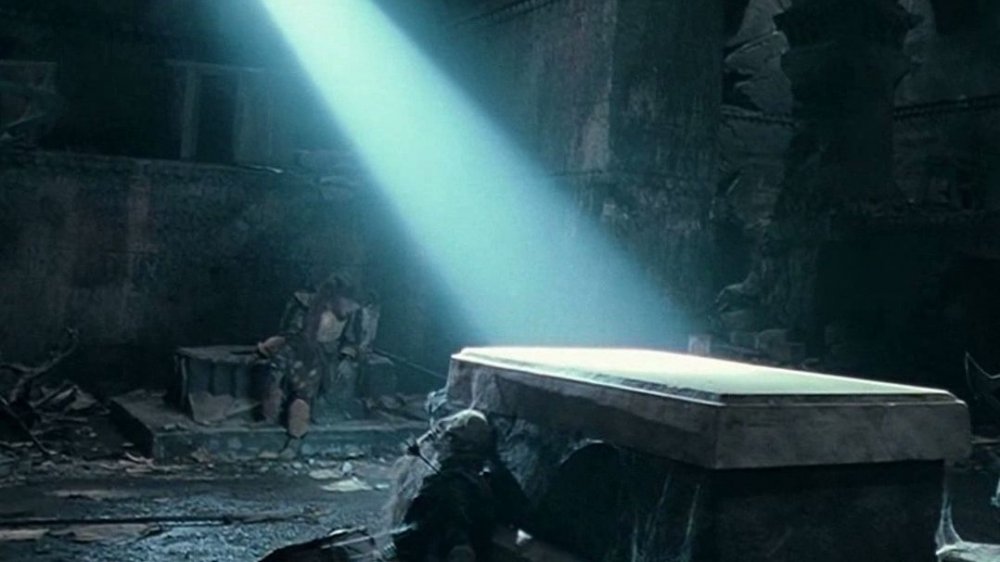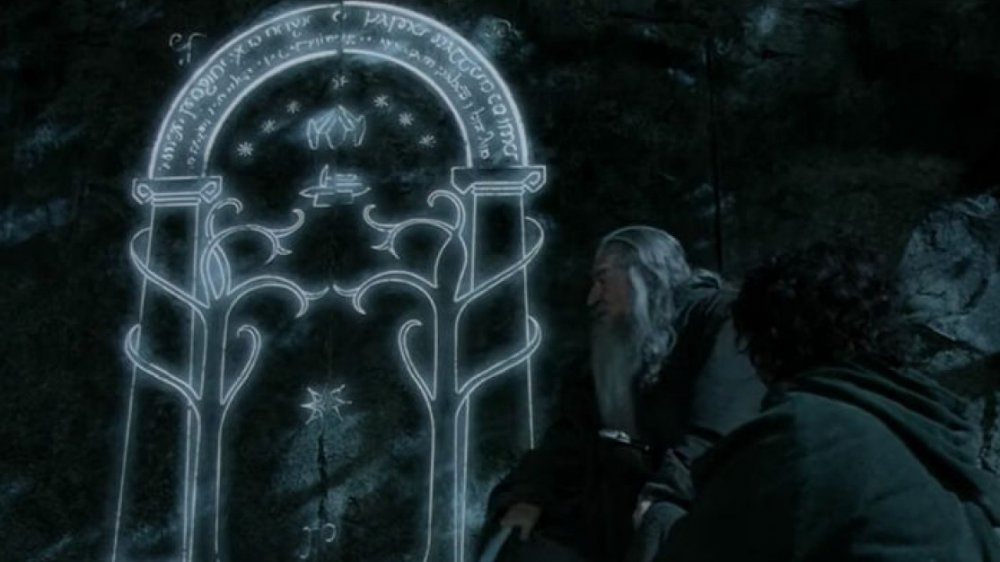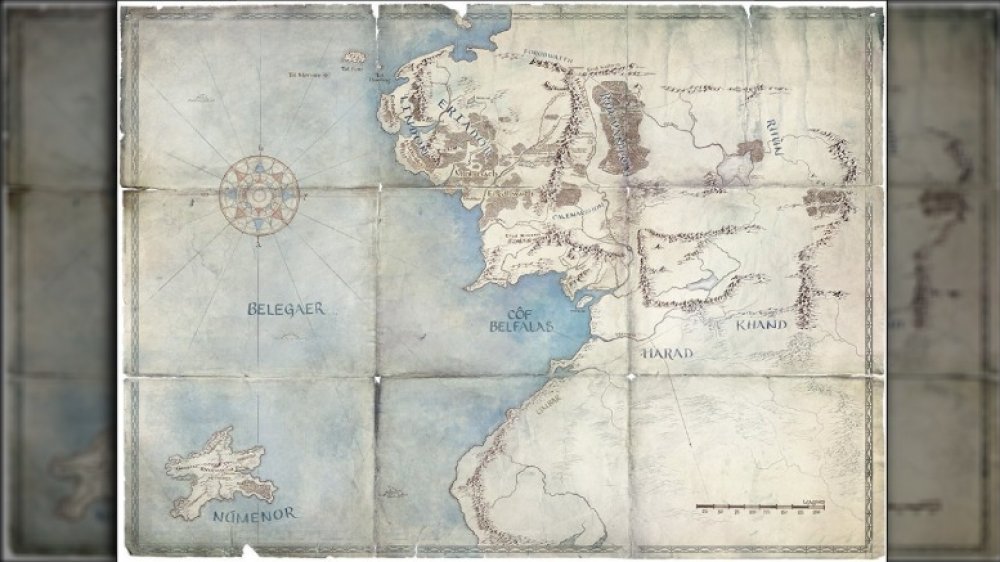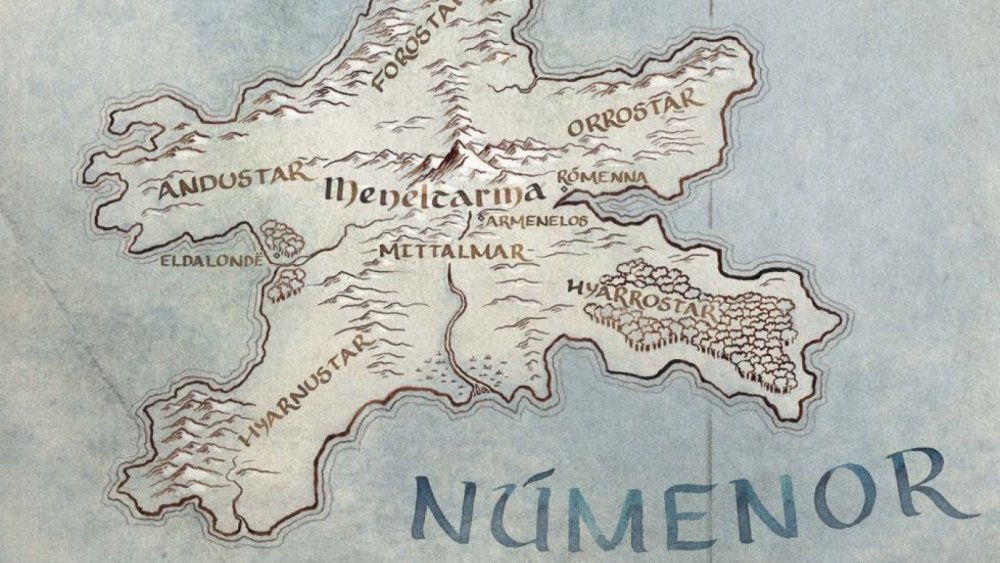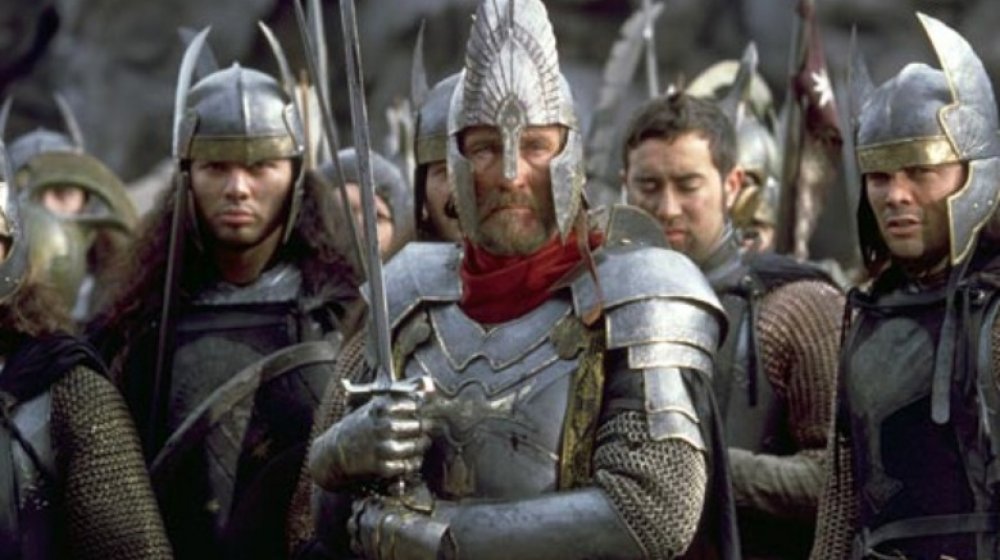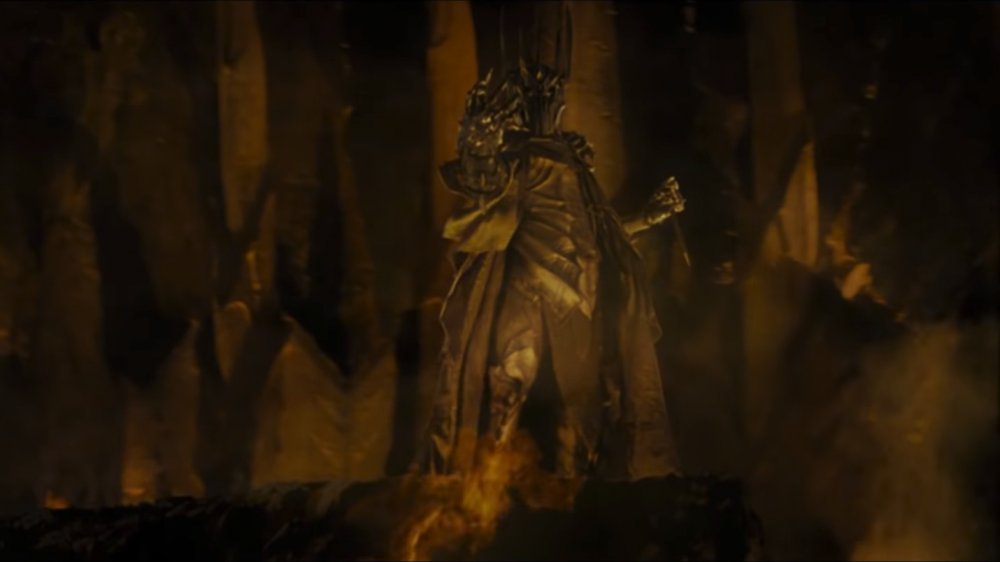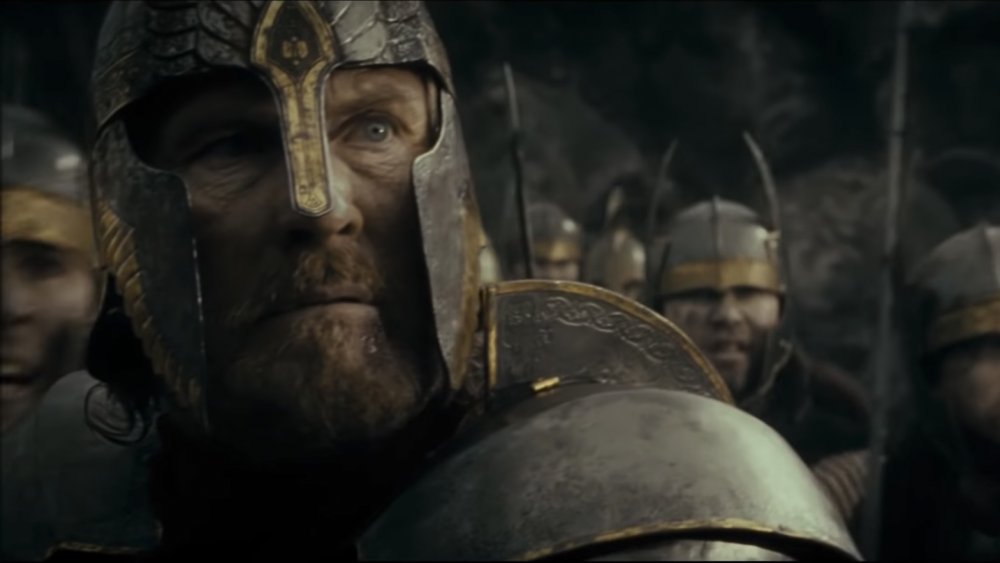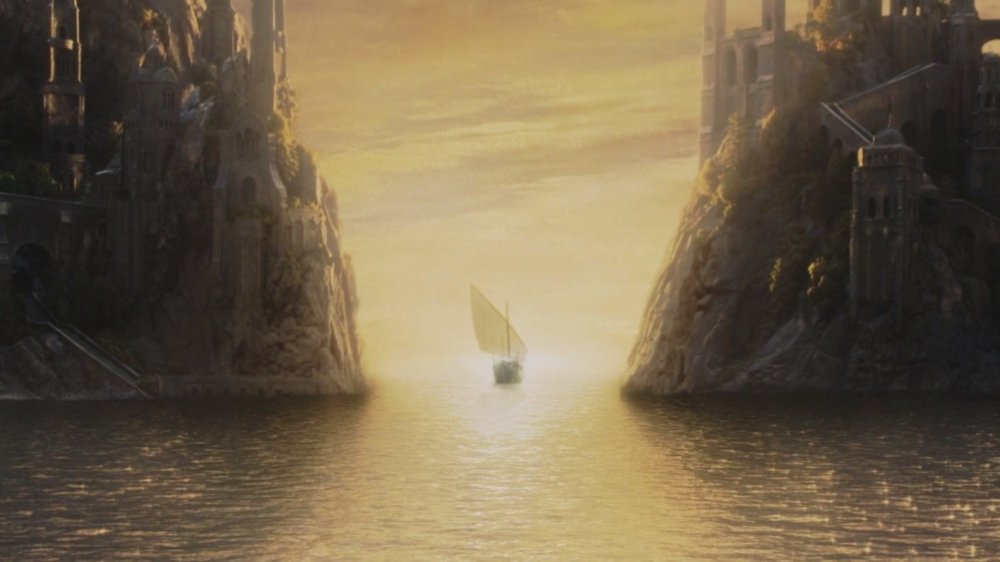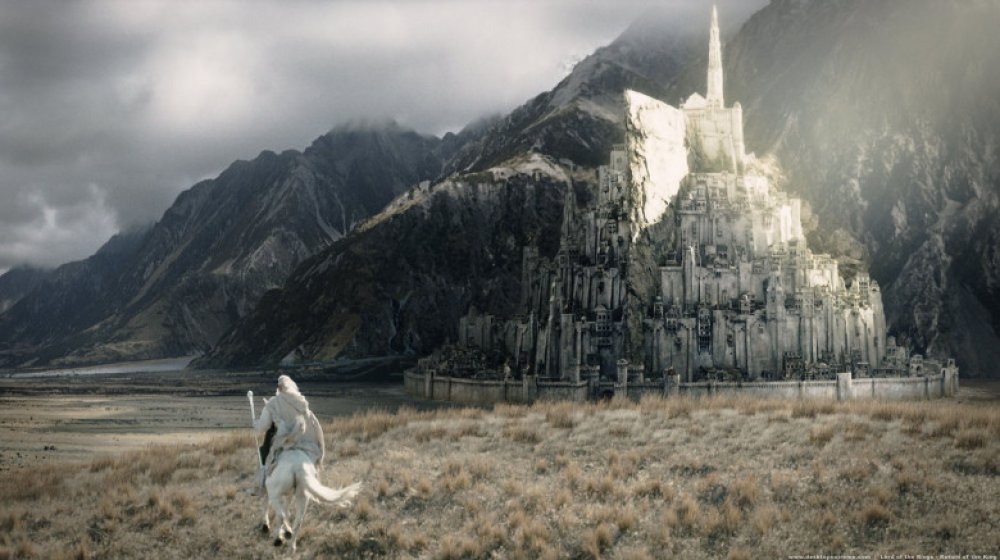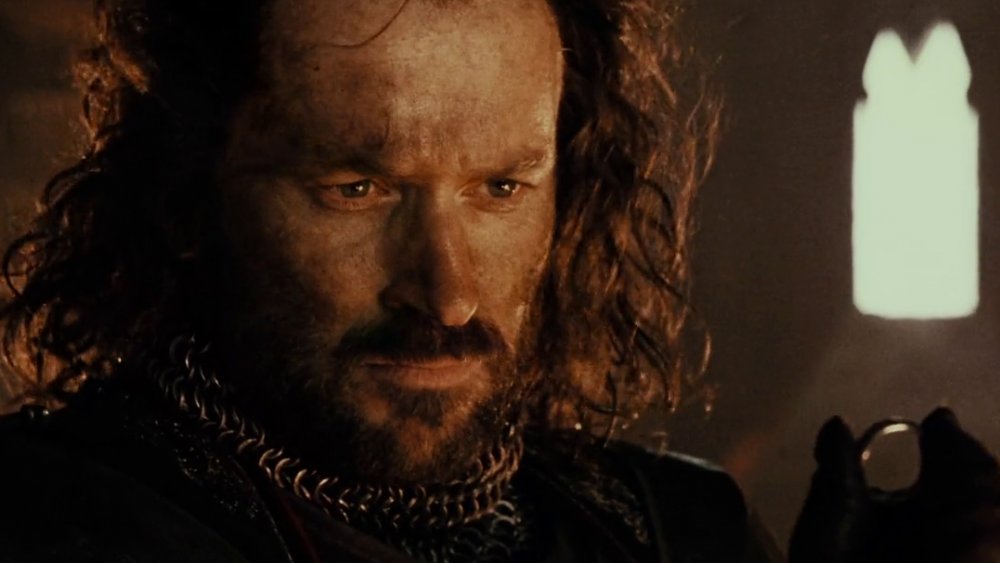Things Fans Want To See In Amazon's Lord Of The Rings Prequel
Amazon is desperate for a tentpole streaming series that will rival the likes of HBO's Game of Thrones, Netflix's The Witcher, and Disney+'s The Mandalorian, and they just might find it in Middle-earth. Having spent over a $1 billion on a Lord of the Rings prequel series, Amazon seems all in when it comes to the world of elves, dwarves, and hobbits.
Naturally, the thought of a Middle-earth-based series summons images of the flowing fields of Rohan, the white city of Gondor, and the calm serenity of the Shire, but as it turns out, Amazon is going for something a little different. Not long after the development of the project began, it was announced that the studio would be taking their show back to the Second Age, thousands of years before the One Ring was destroyed.
While Tolkien aficionados responded to the news with a mixture of excitement and fear — considering how The Hobbit trilogy was mangled — most fans simply raised an eyebrow. The Second Age? What does that even mean? Who lived back then? What even happened that's worth talking about? If you're asking the same questions, never fear. We've dug into the source material to sort things out, and here are a few of the juiciest items that fans would love to see in Amazon's Lord of the Rings prequel series.
We'd love to see the forging of the One Ring in Amazon's prequel series
Everyone is familiar with the One Ring. It's the fancy piece of jewelry that whispers at its owner, makes them invisible, and subtly tries to corrupt them to do evil deeds. It plays a key role in The Hobbit, and it's the central focus of the entire Lord of the Rings story.
But where did the ring come from? Sure, The Return of the King's opening scene and The Shadow of the Past chapter in the books fill us in on the fact that Gollum killed his friend, stole the ring, and then hid it for five centuries deep under the Misty Mountains, but what about before that? Fans must harken back to the earliest moment of The Fellowship of the Ring film in order to piece together a few more tidbits about the One Ring's origin.
As a quick refresher, the ring was originally forged by the Dark Lord Sauron. He did this in order to try to control the elves. While his plan backfired, the forging of the One Ring is still a momentous event in Middle-earth history, as a massive portion of Sauron's power was poured into the shiny bauble. And when, exactly, did all of this ring-making take place? If you're guessing the Second Age, you're absolutely right.
Let's get the history of all the other rings
If you're wondering how Sauron hoped to control the elves through the One Ring, it's a good question. After all, why wouldn't he just use his power to dominate them without funneling it into a tiny golden trinket? Did it amplify his power? Not exactly.
See, Sauron spends a chunk of the Second Age actually helping the elves forge rings of power. He links up with a group of particularly talented elvish craftsmen, led by a fella named Celebrimbor, and he starts to teach them how to forge ultra-powerful jewelry to sell on their Etsy shop. Okay, there's no Etsy shop involved, but still, it's a pretty sweet hobby. Presumably, this is the point where they create the seven rings that eventually go to the dwarves, the nine rings for mortal men, and some other "lesser rings." After Sauron leaves (partly to secretly forge the One Ring), Celebrimbor forges the three elven rings on his own.
When Sauron finishes his ring, he tries to use it to dominate the lords and ladies who are actively wearing the other rings. Unfortunately, he's unable to control the three unadulterated elven rings, which prompts him to attack the elves, kill Celebrimbor, and steal all but the three elven rings, which the elf lord had shipped off to hidden owners. The entire episode is dripping with drama, and it could easily take up a season or more of the show.
The Lord of the Rings prequel could show Sauron's rise to power
For fans of big bad guys, it would be really cool to see the career arc of Sauron as the Dark Lord. See, Sauron is a corrupted Maiar, an angelic spirit that was around before the beginning of time. Early on in the history of Middle-earth, he's lured to the dark side by the first Dark Lord, Morgoth, and he becomes his chief lieutenant.
At the end of the First Age, Morgoth is defeated and banished from the world. Sauron flees in a panic and hides for several centuries. Around 500 years later, Sauron's spirit begins to stir again. He sizes up the situation in Middle-earth and decides that he needs a safe place to plot his revenge.
He decides to set up his own stronghold. At this point, there are still many nations of men far away in the east and south that were originally corrupted by Morgoth back in the day. Hoping to utilize this latent strength, Sauron chooses Mordor as his new stomping ground, and he begins building the Dark Tower of Barad-dûr near Mount Doom. And if you're wondering, yes, that's the same tower that collapses at the end of The Return of the King, although that version is a reconstruction of this original model. Sauron's settling in Mordor is so important to the Lord of the Rings narrative that it would definitely be an origin story worth covering in the series.
Meet Annatar, the gorgeous hunk of an angelic being
It wouldn't be surprising if the creative team at Amazon Studios chooses to focus on Sauron for a hefty portion of the show. After all, we've seen the end of his story, but it's here in the Second Age that the Dark Lord truly comes into his own.
One element of the Sauron story that's going to be fascinating to see is how they portray him earlier on in the age. Everyone and their mother is used to Sauron "the great and terrible." When the villain is mentioned, fans of the movies probably picture one of three things: the ghostly Necromancer from The Hobbit, the hulking rapscallion gussied up in black armor from The Fellowship of the Ring, or the flaming eyeball from the rest of the Lord of the Rings films. But that isn't what Sauron looks like for most of the Second Age — not by a long shot.
In fact, when Sauron first appears on the scene, befriending the elves and generously offering to help them make magic rings, he takes on the appearance of a gorgeous hunk named Annatar, the Lord of Gifts. And this isn't just a "gotcha" trick that he keeps up for a few moments or days or even weeks. He keeps up the duplicitous masquerade of the Annatar schtick for 400 years. In other words, Sauron the handsome could be an integral part of the show for quite a while.
Amazon could show us Sauron as Lord of Middle-earth
Most of The Lord of the Rings centers around Sauron attempting to gain control of Middle-earth by force. Even his pursuit of the One Ring is centered on the fact that it will enable him to dominate the will of others and accelerate his ambitious conquests. Well, it turns out that the War of the Ring isn't Sauron's first taste of domination. In fact, he's simply trying to regain what he had during the Second Age.
After Sauron's attempt to conquer the elves via the One Ring fails miserably, he gathers an army of orcs, trolls, and other evil creatures and attacks the elvish kingdoms. He mostly succeeds and drives the elves back against the western coasts. Just before he gains complete victory, though, a powerful race of men known as the Númenóreans shows up, and they save their elvish allies from total annihilation.
While he doesn't succeed in completely obliterating his enemies, once the war is finished, Sauron controls practically all of Middle-earth, as is reflected in his self-appointed title "Lord of the Earth." It's at this point that he becomes widely known as the Dark Lord. He rules by force and fear and dominates the nations of men that live in the eastern and southern regions of the continent. In fact, they come to look at him as both a lord and a god. This era is called "the Black Years," and it should go without saying that we really, really want to see them play out in the show at some point.
Fans definitely want to see the creation of the Black Riders
While there are tons of details that are worth exploring during the Black Years, there's one little tidbit that would be particularly fascinating to include. After Sauron defeats Celebrimbor and seizes most of the rings of power, he begins to distribute them to various people that he wants to dominate. He gives some of them to dwarven lords, but they're stubborn and uncooperative, and they end up simply becoming obsessed with their treasure hordes.
Men, on the other hand, end up being quite easy to control. So he dishes out nine of the most powerful rings to a group of men who become rich and powerful kings, warriors, and sorcerers. They also appear to receive unending life. However, it doesn't take long before they start to feel the corrupting power of their rings ... and their intimate connection with the dominant One Ring.
Over time, these nine men become permanently invisible, living in a shadow realm in which only the Dark Lord can see them. Like the living dead, they persist in an unendurable life in which they only exist to serve their master, Sauron, the Lord of the Rings. If this all sounds familiar, it's because we've seen these demonic servants before. These are the Nazgûl, the Black Riders that chase Frodo and his friends from the Shire. The origin story of these nine terrible servants of darkness takes place in the Second Age, and it would be a fascinating storyline to develop during the show.
The settling of Rivendell and the Grey Havens
While epic wars and supernatural treasure hunts are clearly the bread and butter of Second Age drama, there are also a few more peaceful items that would absolutely be worth exploring. For instance, this is also the time when a couple of crucial elvish settlements pop up on the map.
Right from the get-go, literally in year one of the Second Age, the elvish dwelling of Mithlond is settled on the northwestern shores of Middle-earth. The faerie harbor is the continent's primary connection to the kind-of other-worldly Blessed Realm (don't ask, it's complicated). Basically, the harbor provides the elves with an opportunity to escape Middle-earth and join their kindred in the west if they want to leave the continent. It's also known as the Grey Havens, and it's the same spot where Frodo and Bilbo finally set sail at the end of The Return of the King.
The other elvish town worthy of note is Rivendell. The stronghold that plays a key role in both The Hobbit and The Lord of the Rings stories is initially founded partway through the Second Age. Elrond — one of the most powerful characters in Lord of the Rings — establishes the refuge after he retreats from Sauron's armies when the Dark Lord defeats Celebrimbor and seizes the rings of power. Considering its importance throughout Middle-earth history, it would be fun to see the inception of this powerful elvish haven in the on-screen adaptation.
Galadriel, Celeborn, and their life outside Lothlorien
Few faces represent the Lord of the Rings trilogy so much as Cate Blanchett — er, Galadriel. The elvish leader is instrumental in helping the Fellowship during The Lord of the Rings, and she gets in on the action during The Hobbit story, as well. And yet, savvy fans know that at that point in the story, Galadriel has already been involved in Middle-earth politics for thousands of years.
By the beginning of the Second Age, Galadriel has already hooked up with her hunky husband, Celeborn, and the elvish power couple spends most of the age slowly moving around Middle-earth. Wherever they are, they usually end up helping to lead some group of wandering elves or another. They also spend time with Celebrimbor, visit Rivendell, and get entangled in political events from time to time.
It's likely around this point that Galadriel receives Nenya, one of the three elven rings that Celebrimbor hides from Sauron. She also eventually gives birth to her daughter, Celebrían, who goes on to become the wife of Elrond and the mother of Arwen — and yes, that makes Galadriel Elrond's mother-in-law and Arwen's grandmother. Needless to say, Galadriel and Celeborn show up throughout the Second Age, and it wouldn't be surprising if, one way or another, they make an appearance in multiple seasons of the show.
We could see Khazad-dûm in action in the Lord of the Rings prequel
Everyone loves the scene in The Fellowship of the Ring when Gandalf duels the Balrog. That confrontation takes place in the dusty remains of Moria — remains which naturally imply that there was a point when Moria was populated. If you wind things back to the Second Age, the kingdom, known as Khazad-dûm, has already been around for a very long time, and it's still filled with dwarves that are alive and well.
And when the elves, led by Celebrimbor, settle down in the next-door region of Eregion, they strike up a harmonious friendship with their dwarven neighbors. Considering the back and forth between Legolas and Gimli and the reception of the dwarves at Rivendell in The Hobbit films, it should come as no surprise that this amicable alliance is anything but the norm for the two kindreds.
Overlooking their racial prejudices, the smithcraft-focused elves of Celebrimbor and the dwarves of Khazad-dûm enjoy a fabulous trading partnership throughout the first half of the age. However, this comes to an abrupt end when Sauron attacks Celebrimbor's people, and the dwarves are forced to shut their gates. They don't do much after this until the very end of the age when they come out to help in the War of the Last Alliance — the events from the very beginning of The Fellowship of the Ring.
What's up with the Doors of Durin?
While the dwarven kingdom of Khazad-dûm plays a fairly integral role throughout most of the Second Age, there's one elf/dwarf joint project that we particularly want to see make its way into Amazon's scripts: the creation of the Doors of Durin.
Khazad-dûm stretches from one side of the Misty Mountains to the other, and on the western side of the mountain range, it has one primary entrance known as the Doors of Durin. Fans of the Peter Jackson films will recognize these glowing apertures from the scene in The Fellowship of the Ring when Gandalf frustratingly fails to remember the password, only to be shown up by Frodo's simple, hobbit logic.
Granted, the Fellowship's encounter with the doors ends with the terrifying Watcher in the Water. However, in the Second Age, the gateway is a much happier place that's often left open, with elves and dwarves passing through with carefree impunity. The gates themselves are designed and built through an extremely rare cooperative effort between the ring-forger Celebrimbor and the dwarven craftsman Narvi, both of whom are recognized as the two greatest artisans of the age. Seeing these gates both being built and then "in action" would be a sweet nod to the Lord of the Rings stories where they ultimately meet their end.
We could witness the creation of Númenor
The next item on our Amazon wish list takes us right off of the mainland and out into the western seas — that is, the left side of your average Middle-earth map. One of the iconic geographic locations of the Second Age is the island of Númenor, also known as Westernesse. This island ends up playing a critical role in the later events of the age. As the Second Age kicks off, though, the landmass literally doesn't exist yet.
The First Age ends with the catastrophic War of Wrath, which leads to a large chunk of western Middle-earth literally being sunk beneath the ocean. In the aftermath of this semi-apocalyptic event, the angelic stewards of the Earth called the Valar raise up a star-shaped island continent that's far enough from the shores of Middle-earth to keep its inhabitants safe from the evils of the mainland. They bless the island, making it extremely fertile, and then offer it as a land of refuge to the men who fought on their side during the War of Wrath. The island is technically called Andor, the Land of Gift, but it ultimately becomes known as Númenor, named after the people that dwell there.
The settling of Númenor
The island of Númenor is created as a gift for men, but of course, if a bunch of god-like creatures lift a chunk of earth out of an ocean, it's not like the mortal men they're giving it to can simply waltz over the water in order to settle down in their new home. So once the island is ready, the Valar put a sign in the sky to guide the future dwellers during their voyage and literally smooth out the ocean waters in order to allow the men to sail to the island without any issues. When they get there, the men find a paradise awaiting them.
The group of men that ultimately found the island of Númenor is led by a guy named Elros, who happens to be Elrond's brother. Due to some complicated family history, the brothers and their children are given the option to live as either mortal men or immortal elves. While Elrond chooses the latter, Elros becomes a mortal king, although he still goes on to live for almost 500 years. The line of kings that come from Elros ultimately leads to none other than Aragorn himself, and it would be a cool throughline to follow in the Prime series.
The romance of Aldarion and Erendis
While the island nation of Númenor lasts throughout most of the Second Age, there are a couple of specific points in the story that could really help spice up the dramatics. The first of these is a tragic romance called "Aldarion and Erendis: The Mariner's Wife." The partially completed story can be found in Tolkien's posthumous book Unfinished Tales, and it follows the romance of the sixth king of Númenor, Aldarion, and his wife, Erendis.
The story focuses on the fact that while Aldarion loves Erendis, she doesn't want to share him with the sea. However, the king is irresistibly drawn towards the water, and he often leaves for years at a time on voyages to Middle-earth. While the two eventually get hitched and even have a kid, Erendis slowly grows bitter and withdraws from the king's court while he's gone.
Interestingly, J.R.R. Tolkien chose to add a twist at the end, in which the apparently awful Aldarion arrives back in Númenor with letters from the elven king Gil-galad, informing everyone that he's actually been performing a critical service in helping to defend Middle-earth against the encroachment of Sauron. Of course, the revelation does little to soften the jaded heart of Erendis, who's spent her entire life feeling trumped by the sea. The story is heart-wrenching, and it could add a fascinating romantic narrative to a season or two of the show.
Amazon might show us mankind vs. Sauron
When Sauron defeats the elves and sets himself up as the ruler of Middle-earth, there's little hope that anything on the continent can stop him. However, by that point, there's an ultra-powerful nation of men that's been building power for centuries out on an island in the midst of the sea, and ultimately, it's these men of Númenor who come to the aid of the Free People on the mainland.
At one point, Sauron gets a little carried away with his success, and he gives himself the title "King of Men." Technically, as far as Middle-earth is concerned, this is pretty close to accurate. After all, by this time, the Dark Lord has been busily conquering all of the nations of men to the south and east, and his empire looks unstoppable. But to the proud Númenóreans, the claim is offensive — so offensive that they hop in their ships and sail to the continent to show Sauron who's in charge.
When the army of the Númenóreans arrive on the mainland, they're so magnificently splendiferous that all of Sauron's servants opt to abandon their master and head for the hills. Faced with few options, Sauron devilishly decides to play up the Númenóreans' pride by willingly surrendering to them. This leads to the Númenóreans taking the Dark Lord back to Númenor as a prison — an event that his captors come to regret quicker than you can say "Bob's your uncle."
Could we witness the fate of Númenor?
Once Sauron arrives on the star-shaped island of Númenor, it doesn't take long before he begins working his charm. Remember, this is the same dude who convinced a bunch of elves to befriend him for a few centuries before they realized who he was. Over time, Sauron weasels his way up from prisoner status to that of an advisor to the Númenórean king, Ar-Pharazôn, a Lord of the Rings character we'd love to see in the Amazon Prime series.
From there, Sauron sets up a cult and even some human sacrifice in Númenor, but his greatest victory comes when he convinces the king to literally attack the Valar, the very beings that gave them their island, in a foolish attempt to claim immortality from them. Of course, the ridiculous plan backfires, and Ar-Pharazôn and his army perish. On top of that, the entire island of Númenor sinks beneath the waves — Atlantis, anyone? — and only a few survivors, known as the Faithful, escape back to their settlements on Middle-earth.
The entire epic of Sauron coming to the island, corrupting its king, and causing it to be completely obliterated could and should be a central theme of the show, as it's far too sensational to leave out.
Fans would love to see the reshaping the world
Another little factoid that takes place when Númenor is destroyed is the literal reshaping of the Earth itself. Up until this time in Middle-earth history, the Earth is a flat plane. It has continents that shift and change over time, but it remains flat nonetheless.
However, when the Númenóreans rebel against the Valar, the angelic stewards of the Earth — unwilling to fight back against these puny mortals who don't know what they're doing — turn to Ilúvatar, the creator of Middle-earth, and ask for help. In fact, it's Ilúvatar who sinks the island nation, and when he does so, he literally changes the shape of the entire world in the process.
After the sinking of Númenor, the Earth becomes an instantly recognizable globe shape. The Blessed Realm, where the Valar live, is removed from this sphere and put in a special, undefined place where only the elves are able to access it. At this point, for understandable reasons, men are never allowed to sail anywhere near that realm again. While it might be a bit challenging to show in a visual medium, the literal shaping of the world from a flat plane to the ol' globe we're all familiar with would certainly be a pretty wild sight, and if they do it right, it could make for a great scene in the show.
The founding of Gondor and Arnor
After Númenor sinks beneath the waves, the narrative of the Second Age shifts back to the mainland. Sauron, having lost his physical form in the chaos, flees back to Mordor where he slowly begins to rebuild his power. In the meantime, the faithful Númenóreans who also survived the wreckage arrive on the mainland. The refugees set about building a new life for themselves, and in the process, they settle two kingdoms that largely set the tone for the entire Third Age: Gondor and Arnor. These two kingdoms are ruled by a gigantic dude named Elendil, who's literally known as Elendil the Tall.
It's these two nations that begin to establish a bunch of landmarks that Lord of the Rings fans should recognize pretty easily. For instance, they build the tower of Orthanc, which the wizard Saruman eventually uses as his headquarters. They also build the white city of Minas Tirith — although initially, it's just a guard tower for their larger capital city. That capital is the city of Osgiliath, which is the ruined city visited by Faramir and his hobbit captives at the end of The Two Towers. The Númenórean refugees also bring the seeing stones that Saruman and Denethor use centuries later, as well as the White Tree that Pippin sees in Minas Tirith. Here's hoping Amazon Studios capitalizes on all these connections to the Peter Jackson films.
The Lord of the Rings prequel might give us the Last Alliance
While the kingdoms of Gondor and Arnor quickly establish themselves, it doesn't take long before they run into their first major roadblock. As survivors of Númenor, the resurgent Dark Lord considers them some of his greatest enemies, and as such, Sauron begins causing trouble for them as soon as he can.
Seeing that their enemy followed them back to Middle-earth, the Númenóreans join with the elves and dwarves and create the Last Alliance. They attack Sauron in Mordor itself, fighting the deadly Battle of Dagorlad in the process. This fight takes place in the same swampy spot that Frodo, Sam, and Gollum cross in The Two Towers. At that point, the area — known as the Dead Marshes — is said to be haunted by the spirits of the soldiers who fell there during the Battle of Dagorlad. See? It all ties together.
Eventually, the Last Alliance defeats Sauron, as can be seen in the opening scenes of The Fellowship of the Ring. Elendil is killed, but his son, Isildur, cuts the One Ring from Sauron's hand and takes it for himself. While we've all seen this sweet and condensed version of the War of the Last Alliance, Amazon has a chance to let all of the dramatics play out over the course of a few episodes or even a whole season, which could be as epic as all get-out.
